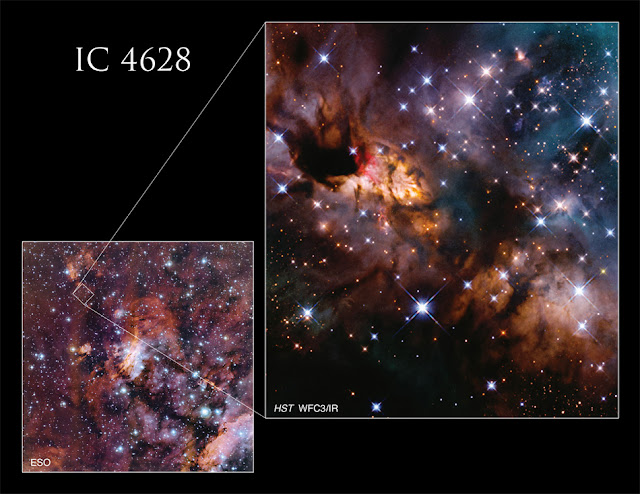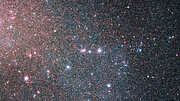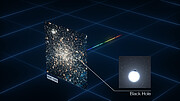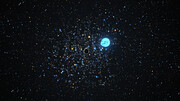Videos
Using the European Southern Observatory’s Very Large Telescope (ESO’s VLT), astronomers have revealed the closest pair of supermassive black holes to Earth ever observed. The two objects also have a much smaller separation than any other previously spotted pair of supermassive black holes and will eventually merge into one giant black hole.
Located in the galaxy NGC 7727 in the constellation Aquarius, the supermassive black hole pair is about 89 million light-years away from Earth. Although this may seem distant, it beats the previous record of 470 million light-years by quite some margin, making the newfound supermassive black hole pair the closest to us yet.
Supermassive black holes lurk at the centre of massive galaxies and when two such galaxies merge, the black holes end up on a collision course. The pair in NGC 7727 beat the record for the smallest separation between two supermassive black holes, as they are observed to be just 1600 light-years apart in the sky. “It is the first time we find two supermassive black holes that are this close to each other, less than half the separation of the previous record holder,” says Karina Voggel, an astronomer at the Strasbourg Observatory in France and lead author of the study published online today in Astronomy & Astrophysics.
“The small separation and velocity of the two black holes indicate that they will merge into one monster black hole, probably within the next 250 million years,” adds co-author Holger Baumgardt, a professor at the University of Queensland, Australia. The merging of black holes like these could explain how the most massive black holes in the Universe come to be.
Voggel and her team were able to determine the masses of the two objects by looking at how the gravitational pull of the black holes influences the motion of the stars around them. The bigger black hole, located right at the core of NGC 7727, was found to have a mass almost 154 million times that of the Sun, while its companion is 6.3 million solar masses.
It is the first time the masses have been measured in this way for a supermassive black hole pair. This feat was made possible thanks to the close proximity of the system to Earth and the detailed observations the team obtained at the Paranal Observatory in Chile using the Multi-Unit Spectroscopic Explorer (MUSE) on ESO’s VLT, an instrument Voggel learnt to work with during her time as a student at ESO. Measuring the masses with MUSE, and using additional data from the NASA/ESA Hubble Space Telescope, allowed the team to confirm that the objects in NGC 7727 were indeed supermassive black holes.
Astronomers suspected that the galaxy hosted the two black holes, but they had not been able to confirm their presence until now since we do not see large amounts of high-energy radiation coming from their immediate surroundings, which would otherwise give them away. “Our finding implies that there might be many more of these relics of galaxy mergers out there and they may contain many hidden massive black holes that still wait to be found,” says Voggel. “It could increase the total number of supermassive black holes known in the local Universe by 30 percent.”
The search for similarly hidden supermassive black hole
pairs is expected to make a great leap forward with ESO’s Extremely
Large Telescope (ELT), set to start operating later this decade in Chile’s Atacama Desert. “This detection of a supermassive black hole pair is just the beginning,” says co-author Steffen Mieske, an astronomer at ESO in Chile and Head of ESO Paranal Science Operations. “With the HARMONI
instrument on the ELT we will be able to make detections like this
considerably further than currently possible. ESO’s ELT will be integral
to understanding these objects.”
More Information
This research was presented in a paper titled "First Direct Dynamical Detection of a Dual Super-Massive Black Hole System at sub-kpc Separation" to appear in Astronomy & Astrophysics (doi: 10.1051/0004-6361/202140827).
The team is composed of Karina T. Voggel (Université de Strasbourg, CNRS, Observatoire astronomique de Strasbourg, France), Anil C. Seth (University of Utah, Salt Lake City, USA [UofU]), Holger Baumgardt (School of Mathematics and Physics, University of Queensland, St. Lucia, Australia), Bernd Husemann (Max-Planck-Institut für Astronomie, Heidelberg, Germany [MPIA]), Nadine Neumayer (MPIA), Michael Hilker (European Southern Observatory, Garching bei München, Germany), Renuka Pechetti (Astrophysics Research Institute, Liverpool John Moores University, Liverpool, UK), Steffen Mieske (European Southern Observatory, Santiago de Chile, Chile), Antoine Dumont (UofU), and Iskren Georgiev (MPIA).
The European Southern Observatory (ESO) enables scientists
worldwide to discover the secrets of the Universe for the benefit of
all. We design, build and operate world-class observatories on the
ground — which astronomers use to tackle exciting questions and spread
the fascination of astronomy — and promote international collaboration
in astronomy. Established as an intergovernmental organisation in 1962,
today ESO is supported by 16 Member States (Austria, Belgium, the Czech
Republic, Denmark, France, Finland, Germany, Ireland, Italy, the
Netherlands, Poland, Portugal, Spain, Sweden, Switzerland and the United
Kingdom), along with the host state of Chile and with Australia as a
Strategic Partner. ESO’s headquarters and its visitor centre and
planetarium, the ESO Supernova, are located close to Munich in Germany,
while the Chilean Atacama Desert, a marvellous place with unique
conditions to observe the sky, hosts our telescopes. ESO operates three
observing sites: La Silla, Paranal and Chajnantor. At Paranal, ESO
operates the Very Large Telescope and its Very Large Telescope
Interferometer, as well as two survey telescopes, VISTA working in the
infrared and the visible-light VLT Survey Telescope. Also at Paranal ESO
will host and operate the Cherenkov Telescope Array South, the world’s
largest and most sensitive gamma-ray observatory. Together with
international partners, ESO operates APEX and ALMA on Chajnantor, two
facilities that observe the skies in the millimetre and submillimetre
range. At Cerro Armazones, near Paranal, we are building “the world’s
biggest eye on the sky” — ESO’s Extremely Large Telescope. From our
offices in Santiago, Chile we support our operations in the country and
engage with Chilean partners and society.
Links
- Research paper
- Photos of the VLT
- For journalists: subscribe to receive our releases under embargo in your language
- For scientists: got a story? Pitch your research
Contacts
Karina Voggel
Strasbourg Observatory, University of Strasbourg
Strasbourg, France
Email: karina.voggel@astro.unistra.fr
Holger Baumgardt
School of Mathematics and Physics, University of Queensland
St. Lucia, Queensland, Australia
Tel: +61 (0)7 3365 3430
Email: h.baumgardt@uq.edu.au
Steffen Mieske
European Southern Observatory
Vitacura, Santiago, Chile
Tel: +56 22 463 3060
Email: smieske@eso.org
Bárbara Ferreira
ESO Media Manager
Garching bei München, Germany
Tel: +49 89 3200 6670
Cell: +49 151 241 664 00
Email: press@eso.org
Source: ESO/News





































